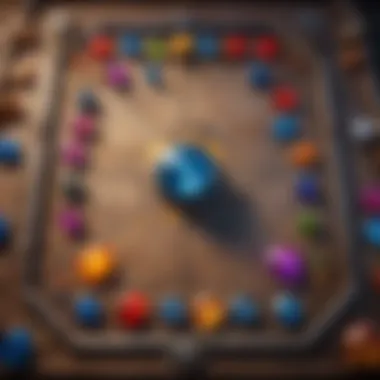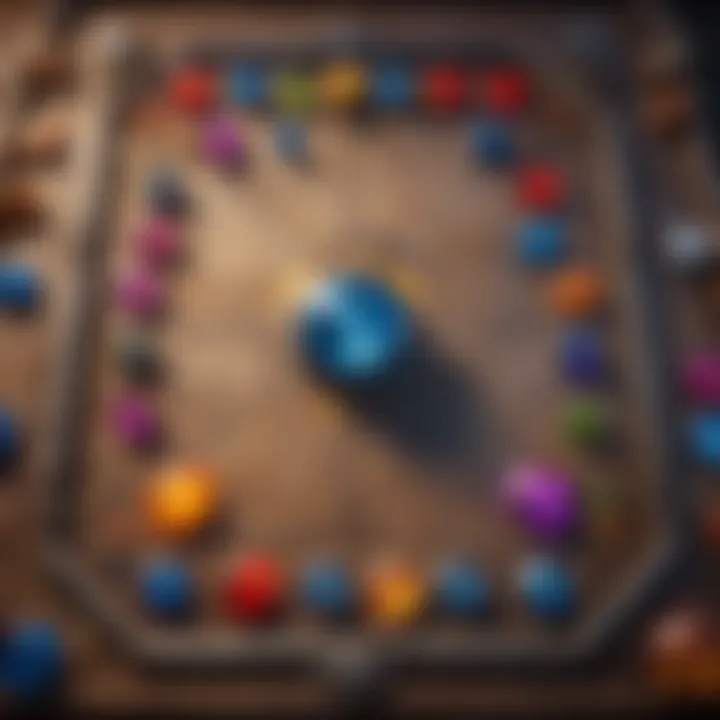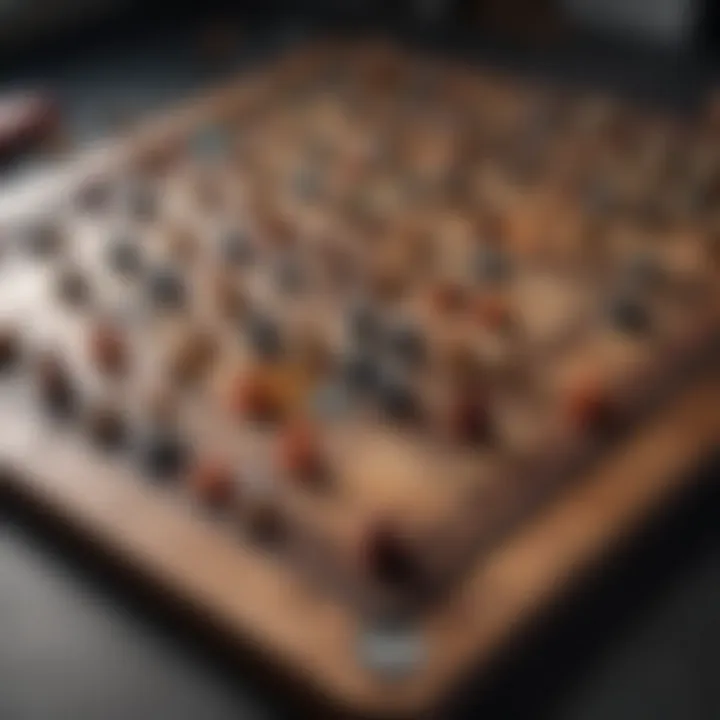A Deep Dive into iPad Match Three Games


Intro
The world of mobile gaming has blossomed over the years, with match-three games standing out as a beloved subgenre. These games, where players swap colorful tiles to form groups of three or more, have captured the hearts of countless individuals across various age groups. On the iPad, this genre has found a perfect platform to thrive, thanks to its spacious touch screen and impressive graphics capabilities. This article takes you on a journey through the fascinating landscape of match-three games for iPad, pulling back the curtain on their evolution and how they've influenced mobile gaming as a whole.
Expect to glean insights into standout titles, the mechanics that keep players hooked, and strategies that can elevate your gaming experience. Here, we will critically evaluate the reasons behind the match-three craze while looking ahead to what the future may hold for this captivating genre.
Game Reviews
Diving into the specifics, let’s scrutinize some popular and noteworthy titles that have made waves on the iPad. Each game will be examined with a lens focused on their unique features, gameplay dynamics, and the artistic direction they take.
Overview of the game
One popular title worth mentioning is Candy Crush Saga. It's hard to find someone who hasn't heard of it. Released in 2012, this game became a hallmark for the match-three genre. Its simple yet addictive formula set the stage for its successors.
Another worthy mention is Bejeweled Blitz. This game took the original match-three mechanics and added a time constraint, making it a fast-paced experience that kept players on their toes.
Gameplay mechanics and features
Each of these games brings its own flavor to gameplay mechanics. Candy Crush Saga employs various boosters and obstacles that challenge the player's strategy, pushing them to think outside the box. For instance, players can use special candy combinations to clear entire rows or columns when they find their groove.
In contrast, Bejeweled Blitz focuses on rapid gameplay, where players race against a timer to rack up points, creating a sense of urgency that many find appealing. The moment-to-moment gameplay differs drastically between these two titles, which is part of what keeps gamers engaged and coming back.
Graphics and sound quality
Visually, both games offer something distinct. Candy Crush Saga is known for its vibrant colors and whimsical art style, appealing to a broad audience, while Bejeweled Blitz opts for a cleaner, more polished look, with its shifting backgrounds and dazzling effects when combos are made.
Sound also plays an important role in the gaming experience. The sound effects in Candy Crush Saga, such as the delightful chime when you make a match, add to the overall enjoyment and contribute to the game's addictive nature.
Pros and cons analysis
While both games are successful, neither is without its flaws.
- Candy Crush Saga:
- Bejeweled Blitz:
- Pros: Engaging and colorful design; various levels and challenges.
- Cons: Some players might find it overly reliant on in-app purchases.
- Pros: Fast-paced and exciting; encourages competition through leaderboards.
- Cons: Limited depth compared to other titles in the genre.
Tips and Strategies
The best way to enjoy match-three games is to come prepared. Let’s lay out some fundamental strategies that can help both newcomers and seasoned players maximize their experience.
Beginner's tips for new players
- Start with easy levels: Don’t rush into difficult stages; build your skills gradually.
- Pay attention to the board: Observe potential matches before making a move.
- Use boosters wisely: Save them for when you really need a helping hand.
Advanced strategies for experienced gamers
- Always look for combinations that could set off a chain reaction.
- Try to create special tiles, as they can be game-changers when used correctly.
Hidden secrets and Easter eggs
Many match-three games hide secrets that can give players an upper hand. Investigating game forums, like those on Reddit, might help unearth various tips or hints that can enhance your game experience.
Future of Match-Three Games
As technology advances, the future of match-three games looks promising. Development teams are likely to continue innovating with new mechanics and enhanced graphics. The integration of augmented reality could take the genre to another level, offering immersive experiences that blend the digital and physical worlds in ways we can only imagine.
Prolusion to Match Three Games
The explosion of mobile gaming has made a significant mark on recreational activities, reclaiming spare moments and turning them into engaging experiences. One prominent aspect of this gaming fabric is the match three genre, which has amassed a colossal following. This section digs into what makes match three games a cornerstone of the mobile gaming landscape and why they deserve attention in any comprehensive overview.


Defining the Match Three Genre
Match three games are deceptively simple yet deeply engaging. At their core, these games involve the player swapping or aligning objects—usually colorful gems, fruits, or candies—to create groups of three or more. By aligning these similar items, players earn points, clear the board, or achieve objectives. The mechanics are easy enough for anyone to pick up, yet offer significant depth for those willing to strategize.
For example, think about Candy Crush Saga. Players are not just matching for the sake of it; each level has specific challenges that may require a bit of cunning and planning. This combination of straightforward mechanics and layered objectives is what swallowed up so many gamers, regardless of age.
Historical Context of Match Three Games
The roots of match three games can be traced back to simple tile-matching puzzles that began to proliferate in the early 2000s. The genre saw a notable milestone with the release of Bejeweled in 2001. This game, while not the first of its kind, essentially set the stage for what would follow. Its addictive nature captured a broad audience and paved the way for many variations and iterations.
Since then, the genre has evolved dramatically. The introduction of mobile devices, particularly the iPad, provided a canvas for game developers to innovate. Fast-paced lifestyle and increasing mobile usage have blended perfectly with the bite-sized gameplay that match three games offer. As a result, newer games like Gardenscapes and Toon Blast have taken the stage, each adding unique twists while still adhering to the core principles established by pioneers like Bejeweled.
Match three games have often mirrored emerging trends in both gaming and technology, serving as a bridge between casual entertainment and deeper gaming mechanics. Overall, their development reflects broader shifts in player preferences and technological advancements, making them a fascinating sub-genre worthy of exploration.
The Appeal of Match Three Games on iPad
The charm of match-three games on the iPad can hardly be overstated. These games draw players in, offering not just entertainment, but a potent blend of simplicity and engagement that keeps users returning for more. This section will dissect the allure of these titles, specifically honing in on three main facets: accessibility and convenience, visuals and user interface design, and community and social features. Together, these elements illustrate why match-three games have carved out such a prominent space in the mobile gaming landscape.
Accessibility and Convenience
One of the significant draws of match-three games is their impressive accessibility. Anyone with an iPad can plunge into the colorful worlds of these games without needing extensive gaming experience. The premise is straightforward: swap gems or candies to form lines of three or more. That simplicity means players of all ages can quickly grasp how to play without extensive tutorials or training.
Moreover, playing on an iPad is inherently convenient. The touch interface allows for natural gestures—the swipes and taps feel intuitive. Whether you're on the bus, lounging at home, or waiting for your coffee to brew, these games fit seamlessly into any part of daily life. As a result, players can enjoy these games in short bursts or longer sessions, depending on their time and mood.
Additionally, the freemium model many of these games adopt ensures that users can start playing at no initial cost, lowering the barrier to entry even further. Players can explore a title and eventually buy upgrades or extras if they choose, allowing for a low-risk way to discover new favorites.
Visuals and User Interface Design
Next, one cannot discuss the appeal of match-three games without addressing the eye-catching visuals and thoughtful user interface design. These games often use vibrant colors, engaging animations, and enchanting sound effects to immerse players in their experience.
The graphics in titles like Candy Crush Saga exhibit a delightful whimsy that captivates the eye. Characters and themes are designed to resonate with a broad audience—they're not just for children. In fact, many adults find the aesthetics charming, reminiscent of a more carefree time.
The user interface also plays a pivotal role in how players engage with the game. An effective UI is one where players can navigate effortlessly, often without a second thought about how they’re doing it. Match-three games generally favor a clean layout, making it easy to view the game board, power-ups, and achievements without clutter or confusion. This ability to keep players oriented boosts their enjoyment and leads to longer gaming sessions.
Community and Social Features
Lastly, the social aspect can’t be overlooked. Match-three games often include features that connect players, providing a shared experience that enhances enjoyment. This can range from simple leaderboards showing friends' scores to collaborative challenges that require teamwork. By enabling players to compete or cooperate, these games cultivate a community spirit.
Taking Candy Crush, for example, players can send and receive lives from friends on Facebook, which not only encourages interaction but also reinforces the game’s addictive qualities. This connectivity makes the experience feel less isolated, as players can cheer on their friends or seek help when stuck on a challenging level.
Top Match Three Games for iPad
In the realm of mobile gaming, match-three games hold a special place, especially for iPad users. The sheer variety in this genre caters to diverse tastes, ensuring that there's something for everyone. Understanding the top match-three games not only enriches the player's experience but also highlights key features and trends within the industry. This section delves into significant titles that have made a mark, dissecting their mechanics, strategies, and appeal both to casual gamers and veterans alike.
Candy Crush Saga
Gameplay Mechanics
Candy Crush Saga showcases some of the most engaging gameplay mechanics that are integral to its success. This game provides players with a straightforward yet addictive approach where matching three candies of the same color leads to delightful cascades and satisfying sounds. What sets it apart is the level-based structure, which keeps pushing players to strategize and think ahead. Unlike mere elimination, players are engaged in crafting combos by matching four or five candies, unlocking special candies that yield powerful effects. The introduction of different objectives in each level, like reaching a specified score or clearing jelly, adds layers to the experience, making it not just about matching but also about accomplishing goals.
Monetization Strategies
When discussing monetization strategies, Candy Crush Saga serves as a predominant example. The game uses a freemium model, where players can download and play for free, but various upgrades and boosters can be purchased. This strategy keeps player engagement high while introducing ways to maximize the developers’ profits. One unique feature here is the lives system—players lose a life for every failed attempt at a level, encouraging them to either wait for regeneration or buy additional lives. While this approach has faced criticism for fostering a potentially frustrating experience, it undeniably has been instrumental in building a colossal user base.
User Base and Popularity
Candy Crush Saga boasts a remarkable user base, with millions of downloads and active players worldwide. The community aspect plays an essential role in its popularity. Players can connect through social media, sharing progress, sending lives, or competing on leaderboards. This interconnectedness enhances engagement and creates a sense of belonging. Notably, the game’s continual updates with new levels and challenges maintain its relevance, ensuring that players always have a fresh experience. However, the vast user base also means significant competition; standing out in such a crowded space requires consistent innovation and attention to player feedback.
Bejeweled Blitz
Unique Features


Bejeweled Blitz offers an interesting twist on the classic match-three format. One of its most notable features is the time-based gameplay, where players have only one minute to score as many points as possible. This creates a frantic pace that challenges players to think and react swiftly. The power gems and bonus multipliers are unique aspects that not only enhance scoring potential but encourage players to develop their own strategies for maximizing their score within the time limit. Its uniqueness in timing compared to other match-three games has kept its audience engaged for years.
Challenges and Game Modes
The game includes various challenges and game modes that enrich the overall experience. Some modes focus on specific objectives, while others allow players to compete against friends or random opponents. This competitive element enhances replay value, as gamers strive to beat their own scores as well as those of their peers. However, the high-score challenge can be both thrilling and daunting; players may feel pressured under competitive conditions, which could be a drawback for some who prefer leisure play.
Critical Reception
Bejeweled Blitz has garnered a largely positive critical reception, with many praising its fast-paced gameplay and vibrant graphics. Critics highlight how it skillfully balances complexity without overwhelming new players. The game’s reception reflects its core appeal—mixing accessibility with competitive elements. However, some reviews mention the occasional frustration with the random nature of obstacles and gem appearances, impacting fairness in gameplay. Nevertheless, it remains a staple in discussions about successful match-three titles.
Gardenscapes
Story Integration
Gardenscapes is exemplary in blending narrative with gameplay, gracefully integrating a rich story into the match-three experience. Players are tasked with restoring a garden, which unfolds as they progress through levels. The crafting of a storyline around tasks provides an element of purpose to the gameplay. This commitment to a narrative framework has proven beneficial, keeping players engaged as they want to see how their efforts translate into the garden's evolution. This kind of story integration fosters emotional investment, often leading to a more fulfilling experience.
Gameplay Dynamics
The gameplay dynamics in Gardenscapes take a multifaceted approach by weaving different elements together. Apart from the classic match-three mechanics, players encounter puzzles, resource management, and interactions with various characters throughout the garden. This dynamic mix makes sure players are not just matching tiles but also navigating through an adventure, making choices that affect the storyline. This blend of genres can be both an advantage and disadvantage—some players love the change, while others might find it a tad overwhelming at first.
Cross-Platform Elements
Gardenscapes emphasizes cross-platform elements, allowing players to transition between devices. This feature is critical in today’s gaming landscape, where flexibility and accessibility are increasingly important. Gamers can start a session on their iPad and later continue on their smartphone without losing progress. This level of convenience is a clear benefit, catering to busy individuals who should jump back into their game as per their schedule. However, it also raises concerns about how these elements might affect in-game competition and community interactions, as players on different platforms could face disparities.
Game Mechanics in Match Three Titles
The world of match-three games is rich and complex, with gameplay mechanics that bind players to the screen for hours on end. These mechanics aren’t just frills or afterthoughts; they are the heart of what makes each title grasping for attention in a crowded app store. Engaging with these games involves understanding how these mechanics work, what benefits they bring to the gameplay experience, and how they're designed to keep a player returning for more.
Core Gameplay Loops
At the core of every match-three game lies the gameplay loop, a cycle that enhances player engagement. This loop generally consists of three main actions: matching, clearing, and earning rewards. When you match three or more items, they disappear, opening up the board for new pieces and creating a cascade effect that often leads to strategic bonuses. The satisfaction that travels through the player each time they clear a set of items engages both the left and right hemispheres of the brain, rewarding logical thinking while still sparking sheer delight.
Moreover, players become invested in improving their skills as the game presents increasingly difficult levels. Challenges that require critical thinking and quick reflexes keep players from wandering off, creating a loop that encourages continuous play.
Progression Systems
Progression systems in match-three games are like the bread and butter of their appeal. They provide a sense of advancement that every player seeks. These systems often manifest through different means: level progression, score accumulation, and unlockable content. Each time players accomplish a task, such as reaching a new level or achieving a high score, there's a rush—a feeling that one is moving forward in their gaming journey.
Games like Candy Crush Saga often incorporate daily challenges or special events, which further enhance this sense of progression and achievement. Players are not just clearing pieces; they are chasing after new avatars, unique items, or exclusive levels that make the experience feel richer and more rewarding.
Power-Ups and Combos
Power-ups and combos are game-changers in the match-three genre, adding layers of strategy that can transform routine match-ups into exhilarating encounters. Power-ups often become available through specific actions, be it matching a certain number of unique pieces or obtaining them through leveling up. They create opportunities for players to break the mold—literally.
Combos are another vital aspect, where players can chain matches together in one move. A succession of matches not only yields higher points but also generates unique effects. Consider the satisfaction of clearing an entire row or column with a single move. It's a little win that provides incentive to learn the boards and discover new strategies, rewarding exploration and innovation on each level.
"The joy in making combos isn’t just the points; it’s the thrill of being strategic and thinking ahead."
Understanding these game mechanics helps players navigate through different titles with an eye for optimizing their skills. Knowing how to harness the layers of strategy, progression, and powerful moves is essential for anyone looking to really enjoy the depth this genre has to offer.
Strategic Considerations for Gamers
When diving into the world of match-three games on iPad, understanding strategic considerations can make all the difference between a casual player and a formidable contender. This section will unravel essential elements that every gamer should contemplate. It’s not simply about matching tiles; having a tactical mindset can boost your performance significantly.
Optimal Play Strategies
Crafting an effective gameplay strategy is a crucial aspect of succeeding in match-three games. Here are a few key strategies that can enhance your gaming experience:
- Understand the Board Layout: Each game has its unique configurations. Spending a smidgen of time at the beginning to gauge the board can lead to better moves later on.
- Plan Moves Ahead: Think a couple of steps ahead instead of reacting to each move immediately. This foresight is vital. For instance, if you see a potential combo forming, try to anticipate how other pieces will fall and rearrange your plans accordingly.
- Use Power-Ups Wisely: Power-ups can be game-changers, but utilizing them at the right moment is critical. Save them for challenging levels or when you see multiple moves aligning for an explosive combo.
- Focus on Higher-Value Tiles: If the game has different tile types, focusing on clearing the higher-value or more complex tiles can lead to bigger bonuses and more favorable board conditions.
These strategies are not just tips; they are keys to unlocking the full potential of your gaming endeavors. Much like playing chess, it’s about foreseeing your opponent's move and countering acutely.


Avoiding Common Pitfalls
While honing in on strategies is essential, it’s equally important to steer clear of typical traps that many gamers stumble into. Here are some pitfalls to avoid:
- Rushing Decisions: A hasty play might seem tempting, but often it leads to regret. Take a moment to consider each move. Sometimes a dropped tile can change the entire dynamic of the game.
- Neglecting Challenges: Every game throws in challenges or obstacles. Ignoring them in favor of simply matching tiles can hinder your advancement. Sometimes the most beneficial move isn’t apparent but arises through addressing these hurdles.
- Getting Stuck in a Pattern: If you find yourself following the same routine in handling levels, it may become a crutch that stifles your progress. Each level should be approached with fresh eyes.
- Forgetting to Experiment: Whether it's testing out new power-ups or trying different gameplay approaches, don’t shy away from experimenting. Innovation in play can sometimes lead to unforeseen advantages.
"In gaming, as in life, it’s not just about the destination, but the journey itself. Strategy shapes that journey, defining victories and the lessons learned from defeats."
To summarize, being aware of these strategic considerations equips gamers with the arsenal needed to not just survive, but thrive. Master these aspects, and you’ll not just enjoy the match-three experience, but truly excel and extract every ounce of joy from it. Remember, gaming is a blend of strategy, timing, and a sprinkle of intuition.
Comparative Analysis of Top Titles
When it comes to match-three games on the iPad, a comparative analysis of top titles reveals much about the genre's evolution, gameplay mechanics, and user engagement. This section dives deep into how various games stack up against one another, allowing players to understand what makes each title unique. This understanding helps gamers make informed choices based on their preferences.
Gameplay Experience Comparison
A significant aspect of match-three games is how they deliver an experience to the player. Often, the core gameplay mechanics revolve around matching colorful tiles or gems, but the nuances can greatly influence the overall enjoyment. For instance, Candy Crush Saga has a straightforward matching mechanic but layers in levels with diverse objectives, increasing complexity as players progress. In contrast, Gardenscapes integrates storytelling into its gameplay, allowing players to immerse themselves in a narrative while strategizing their moves.
- Challenge Level: The type and frequency of challenges can impact how players interact with the game. Bejeweled Blitz offers quick, timed challenges that appeal to players looking for instant gratification. Meanwhile, Candy Crush leads players through a carefully designed pace that unfolds slowly, which can either draw in or frustrate players depending on their play style.
- Reward Systems: Each game has its own approach to rewarding players for their achievements. In Gardenscapes, completing levels not only achieves match goals but also unlocks elements of a storyline, which keeps players hooked. Meanwhile, Bejeweled Blitz leans on leaderboards and social interactions to boost competitiveness among friends or rivals.
In summary, a comparative analysis of gameplay experiences highlights how different games satisfy distinct player desires, whether it’s a narrative-driven journey, a competitive streak, or a straightforward puzzler.
Visual and Audio Aesthetics
The visual and audio elements of a match-three game significantly contribute to its overall atmosphere and engagement level. In this genre, first impressions matter, and the way a game looks and sounds can either draw a player in or leave them cold. Gardenscapes and Candy Crush Saga both showcase visually stunning graphics, each with its own unique art style.
- Art Style: Candy Crush opts for a bright, candy-themed aesthetic, with vibrant colors and animations that pop off the screen. This creates a very cheerful ambiance, making the player feel like they are in a magical candy land. Meanwhile, Gardenscapes incorporates lush, detailed landscapes and whimsical character designs that evoke a sense of charm and exploration.
- Audio Experience: Sound effects and background music also play crucial roles in creating an immersive environment. Candy Crush Saga features upbeat music and satisfying sound effects that signal successes and failures, reinforcing the gameplay loop. In comparison, Gardenscapes has a gentle score and sound effects that enhance the relaxed yet engaging feel of the game, making it less about competition and more about discovery.
"The power of aesthetics in gaming first captivates with visuals, but it's the sound that pulls you deeply into the world of match-three games."
Future Trends in Match Three Gaming
The rapidly changing landscape of gaming technology paves the way for innovative trends within the match-three genre. As these games continue to carve a niche on the iPad, understanding these trends is vital for developers and players alike. Emerging technologies and evolving expectations among players play crucial roles not just in attracting new users but also in retaining veteran players who seek fresh experiences. By analyzing specific elements and benefits, one can gain insights into the direction the genre is heading.
Emerging Technologies
The incorporation of advanced technologies has become increasingly important in enhancing the match-three gaming experience.
- Augmented Reality (AR): This tech has the potential to create immersive worlds by blending real environments with digital game elements. Imagine swapping gems or candies while physically moving around your living room!
- Artificial Intelligence (AI): As developers implement more intelligent algorithms, AI can customize gameplay based on individual user patterns. Tailoring challenges to match a player’s skill level ensures that seasoned gamers aren’t left yawning due to easy tasks, while newcomers can comfortably learn the ropes.
- Cloud Gaming: With the rise of services like Google Stadia, cloud gaming allows players to access titles without worrying about hardware limitations. This evolution could usher in even more complex match-three games than previously possible on the iPad.
"Innovative technologies not only breathe new life into existing titles, but they can also set the stage for entirely new match-three experiences that redefine the genre."
Evolving Player Expectations
The player base of match-three games is no longer a homogenous group. Today, the expectations of gamers are varied and complex.
- Narrative-driven Experiences: Players seek more than just swapping tiles; they crave stories interwoven with gameplay. This aspect adds depth and engagement as they progress through levels to uncover plot twists.
- Customization Options: Users are inclined to personalize their gaming experience. Unique avatars, customizable power-ups, or themed boards can greatly enhance player engagement.
- Social Connectivity: The necessity for community and connectivity has grown. Players desire features that enable them to interact with one another, share milestones, and even compete in tournaments.
As developers grasp these trends, adapting their strategies accordingly, they can create games not only that retain players but also inspire new audiences to join the match-three phenomenon. With technology and expectations at the forefront, the future of match-three games looks promising.
Finale and Final Thoughts
In summing up the diverse and engaging world of match-three games for the iPad, it becomes clear that this genre stands as a significant player in the mobile gaming landscape. These games have not just captivated gamers but have established a robust presence within the digital entertainment sphere. The relevance of understanding this genre is multifaceted; not only does it showcase the evolution of gaming on handheld devices, but it also highlights the key mechanics and social elements that make these games so addictive.
Summary of Insights
Throughout this article, we have unraveled the intriguing components that contribute to the success of match-three games. Some crucial insights include:
- Gameplay Mechanics: The simple yet captivating mechanics of matching elements create a cycle of challenge and reward that keeps players engaged.
- User Experience: The design and interface are integral, as they must cater to both novice and experienced players, evoking a sense of flow while maintaining clarity.
- Community Engagement: The social features within these games foster connections among players, enhancing the overall experience and driving longevity.
"The beauty of match-three games lies in their ability to captivate a wide audience through accessible gameplay and compelling social dynamics."
These points not only paint a picture of why these games appeal to a broad demographic but also underline their lasting influence on mobile gaming culture.
The Lifespan of Match Three Games
Looking ahead, the lifespan of match-three games appears promising, albeit with necessary adaptations. As technology evolves, so too do player expectations. Innovations like augmented reality and advanced graphics are likely to reshape the genre. The continuous influx of fresh ideas will be crucial, as developers strive to retain engagement in a competitive market.
Moreover, the current trend toward narrative-driven experiences within these games suggests that storytelling might play a more prominent role. When harmonized with classic match-three mechanics, incorporating elaborate story arcs could engage players more deeply and elevate their gaming experience.



